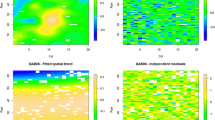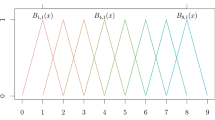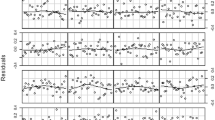Abstract
This article examines the practical use of semiparametric models in the analysis of field trials—that is, models with parameterized treatment effects and additive terms derived by a data-driven approach using a locally weighted running line smoother (loess). We discuss graphical methods to identify spatial structure in the data and model selection procedures to choose the degree of smoothing. Once the spatial part of the model has been chosen, hypotheses about the treatment effects may be tested. Semiparametric models are used to analyze two barley field trials exhibiting spatial trends. The first has a single experimental treatment and a row-column design. The second has a split-plot design, and we use a semiparametric model which accounts for the randomization at the different strata of this design. We compare the semiparametric analyses with classical analyses of variance and with alternative spatial models. We find that semiparametric models give a good insight into spatial variation in the field and can improve the precision of parameter estimates.
Similar content being viewed by others
References
Akaike, H. (1973), “Information Theory and an Extension of the Maximum Likelihood Principle,” in Second International Symposium on Information Theory, eds. B. N. Petrov and F. Csaki, Budapest: Akademia Kiado, pp. 267–281.
Buja, A., Hastie, T., and Tibshirani, R. (1989), “Linear Smoothers and Additive Models” (with discussion), The Annals of Statistics, 17, 453–555.
Butler, D. G., Gilmour, A. R., and Cullis, B. R. (1999), “SAMM: An S-PLUS Module for Mixed Models using REML,” in International S-PLUS User Conference, New Orleans, USA.
Cleveland, W. S. (1979), “Robust Locally-Weighted Regression and Smoothing Scatterplots,” Journal of the American Statistical Association, 74, 829–836.
— (1993), Visualizing Data New Jersey: Hobart Press.
Cleveland, W. S., and Devlin, S. J. (1988), “Locally-Weighted Regression: An Approach to Regression Analysis by Local Fitting,” Journal of the American Statistical Association, 83, 596–610.
Craven, P., and Wahba, G. (1979), “Smoothing Noisy Data with Spline Functions,” Numerische Mathematik, 31, 377–403.
Cullis, B. R., and Gleeson, A. C. (1991), “Spatial Analysis of Field Experiments — an Extension to Two Dimensions,” Biometrics, 47, 1449–1460.
Durban, M. L. (1998), “Modelling Spatial Trends and Local Competition Effects Using Semiparametric Additive Models,” unpublished Ph.D. thesis, Heriot-Watt University, Dept. of Actuarial Mathematics and Statistics.
Durban, M., Hackett, C. A., and Currie, I. D. (1999), “Approximate Stand and Errors in SemiParametric Models,” Biometrics, 55, 699–703.
Edmondson, R. N. (1993), “Systematic Row-and-Column Designs Balanced for Low-Order Polynomial Interactions Between Rows and Columns,” Journal of the Royal Statistical Society, Series B, 55, 707–723.
Federer, W. T., and Meredith, M. P. (1992), “Covariance Analysis for Split-Plot and Split-Block Designs,” The American Statistician, 46, 155–162.
Gilmour, A. R., Cullis, B. R., and Verbyla, A. P. (1997), “Accounting for Natural and Extraneous Variation in the Analysis of Field Experiments,” Journal of Agricultural, Biological and Environmental Statistics, 2, 269–293.
Green, P., Jennison, C., and Seheult, A. (1985), “Analysis of Field Experiments by Least Squares Smoothing,” Journal of the Royal Statistical Society, Series B 47, 299–315.
Green, P. J., and Silverman, B. W. (1994), Nonparametric Regression and Generalized Linear Models: A Roughness Penalty Approach, London: Chapman & Hall.
Hackett, C. A., Reglinski, T., and Newton, A. C. (1995), “Use of Additive Models to Represent Trends in a Barley Field Trial,” Annals of Applied Biology, 127, 391–403.
Hastie, T. J., and Tibshirani, R. J. (1986), “Generalized Additive Models,” Statistical Science, 1, 297–318.
— (1987), “Generalized Additive Models: Some Applications,” Journal of the American Statistical Association, 82, 371–386.
— (1990), Generalized Additive Models, London: Chapman & Hall.
Hurvich, C. M., Simonoff, J. S., and Tsai, C.-L. (1998), “Smoothing Parameter Selection in Nonparametric Regression Using An Improved Akaike Information Criterion,” Journal of the Royal Statistical Society, Series B, 60, 271–293.
Koo, J. Y., and Lee, Y. (1994), “Bivariate B-Splines in Generalized Linear Models,” Journal of Statistical Simulation and Computation, 50, 119–129.
Newton, A. C., Ellis, R. P., Hackett, C. A., and Guy, D. C. (1997), “The Effect of Component Number on Rhynchosporium secalis Infection and Yield in Mixtures of Winter Barley Cultivars,” Plant Pathology, 45, 930–938.
Papadakis, J. S. (1937), “Methode statistique pour des experiences surchamp,” Bulletin de l’Institut d’Amelionation des Plantes a Salonique, 23.
Speckman, P. (1988), “Kernel Smoothing in Partial Linear Models,” Journal of the Royal Statistical Society, Series B, 50, 413–436.
Stone, M. (1974), “Cross-Validatory Choice and Assessment of Statistical Predictions” (with discussion). Journal of the Royal Statistical Society, Series B, 36, 111–147.
Verbyla, A. P., Cullis, B. R., Kenward, M. G., and Welham, S. J. (1999), “The Analysis of Designed Experiments and Longitudinal Data by using Smoothing Splines” (with discussion). Applied Statistics, 48, 269–311.
Wahba, G. (1990), Spline Models for Observational Data, Philadelpia: SIAM.
Welham, S. J., and Thompson, R. (1997), “Likelihood Ratio Tests for Fixed Model Terms Using Residual Maximum Likelihood,” Journal of the Royal Statistical Society, Series B, 59, 701–714.
Williams, E. R., and John, J. A. (1996), “Row-Column Factorial, Designs for Use in Agricultural Field Trials.” Applied Statistics, 45, 39–46.
Wilkinson, G. N., Eckert, S. R., Hancock, T. W., and Mayo, O. (1983), “Nearest Neighbour (NN) Analysis of Field Experiments” (with discussion). Journal of the Royal Statistical Society, Series B. 45, 151–211.
Author information
Authors and Affiliations
Additional information
Maria Durban carried out this work while based with Biomathematics and Statistics Scotland at the Scottish Crop Research Institute. Christine Hackett is the corresponding author.
Rights and permissions
About this article
Cite this article
Durban, M., Hackett, C.A., McNicol, J.W. et al. The practical use of semiparametric models in field trials. JABES 8, 48–66 (2003). https://doi.org/10.1198/1085711031265
Received:
Revised:
Issue Date:
DOI: https://doi.org/10.1198/1085711031265




